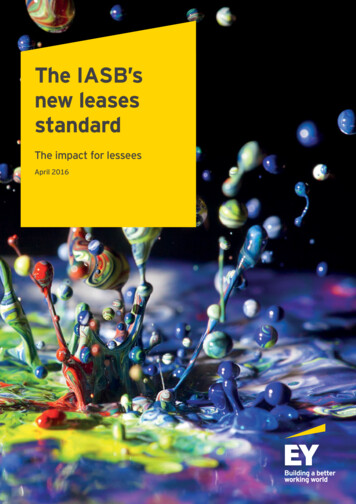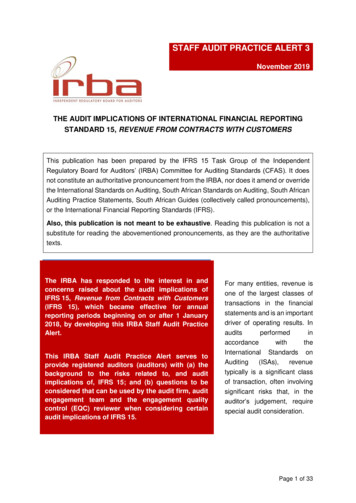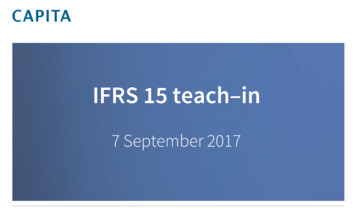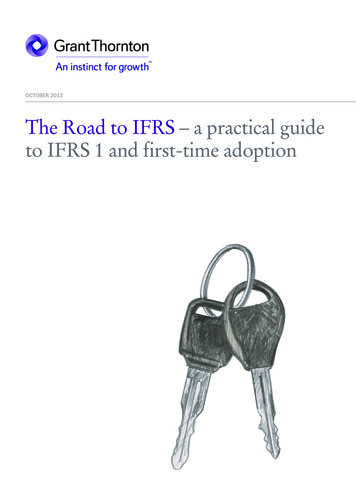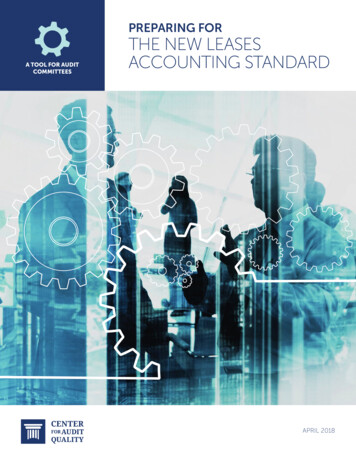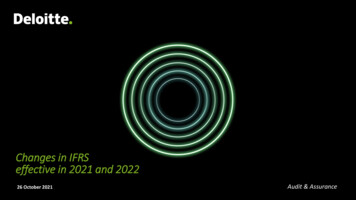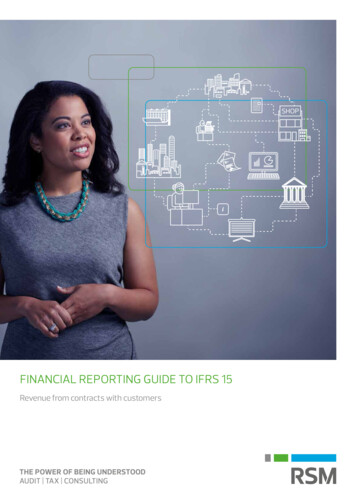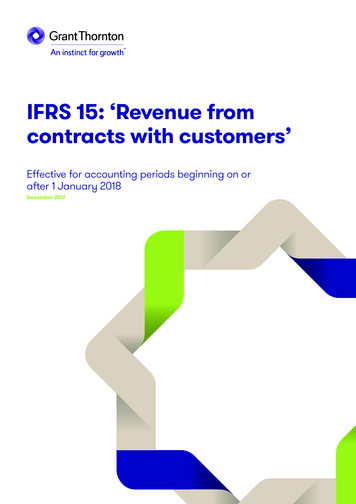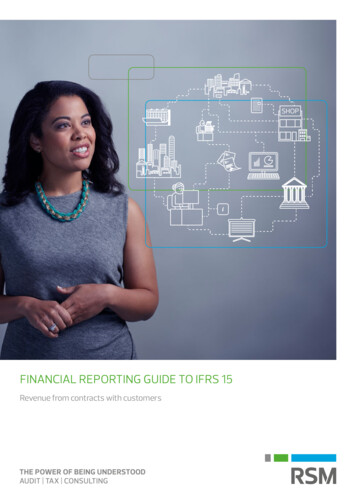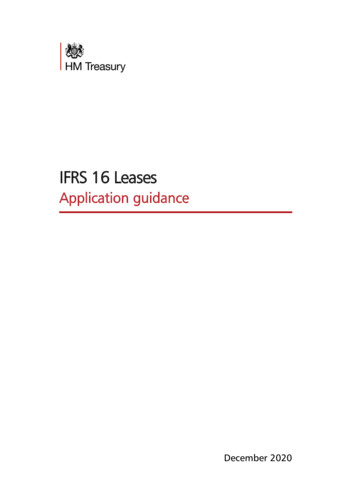
Transcription
IFRS 16 LeasesApplication guidanceDecember 2020
IFRS 16Application guidanceDecember 2020
Crown copyright 2018This publication is licensed under the terms of the Open Government Licence v3.0 exceptwhere otherwise stated. To view this licence, visit /version/3 or write to the Information Policy Team, The NationalArchives, Kew, London TW9 4DU, or email: psi@nationalarchives.gov.uk.Where we have identified any third party copyright information you will need to obtainpermission from the copyright holders concerned.This publication is available at www.gov.uk/government/publicationsAny enquiries regarding this publication should be sent to us atpublic.enquiries@hmtreasury.gov.ukISBN 978-1-911375-XX-X PUXXXX
ContentsExecutive summary2Chapter 1Recognition exemptions6Chapter 2Definition of a lease8Chapter 3Lessee accounting12Chapter 4Peppercorn leases16Chapter 5Lessee disclosures18Chapter 6Lessor accounting: subleases22Chapter 7Transition arrangements23Chapter 8Whole of Government Accounts27Chapter 9Budgets and Estimates28Appendix 1Discounting lease liability291
Executive summaryIFRS 16 LeasesIFRS 16 Leases is being applied by HM Treasury in the Government FinancialReporting Manual (FReM) from 1 April 2022 (with limited options for early adoptionfrom 1 April 2019 and 1 April 2021).IFRS 16 sets out the principles for the recognition, measurement, presentation anddisclosure of leases and replaces the previous Standards IAS 17 Leases and relatedIFRIC and SIC Interpretations. The IASB published IFRS 16 because it was aware thatthe previous lease accounting model was criticised for failing to provide a faithfulrepresentation of leasing transactions. In particular, the previous accounting modelmade a distinction between finance and operating leases, and did not requirelessees to recognise assets and liabilities arising from operating leases.IFRS 16 introduces a single lessee accounting model that results in more faithfulrepresentation of a lessee’s assets and liabilities and, together with enhanceddisclosures, will provide greater transparency of a lessee’s financial leverage andcapital employed.IFRS 16 requires a lessee to recognise assets and liabilities for leases with a term ofmore than 12 months, unless the underlying asset is of low value. A lessee isrequired to recognise a right-of-use asset representing its right to use the underlyingleased asset and a lease liability representing its obligation to make lease payments.As a consequence, a lessee also recognises depreciation of the right-of-use asset andinterest on the lease liability, and classifies cash repayments of the lease liability intoa principal portion and an interest portion and presents them in the statement ofcash flows applying IAS 7 Statement of Cash Flows.IFRS 16 also contains disclosure requirements for lessees. Lessees will need to applyjudgement in deciding upon the information to disclose in order to meet theobjective of providing a basis for users of financial statements to assess the effectthat leases have on the financial position, financial performance and cash flows ofthe lessee. Entities are reminded to use the principles of materiality that flowthrough all accounting standards to ensure they provide relevant and reliableinformation about leases in the financial statements.IFRS 16 substantially carries forward the lessor accounting requirements in IAS 17.Accordingly, a lessor continues to classify its leases as operating leases or financeleases, and to account for those two types of leases differently. However, there arechanges to the classification guidance for subleases, and enhanced disclosurerequirements that will improve information disclosed about a lessor’s risk exposure,particularly to residual value risk.2
FReM interpretations and adaptationsThe FReM interprets and adapts IFRS 16 for the public sector context in several ways.IFRS 16, as adapted and interpreted by the FReM, will be effective from 1 April2022, with two exceptions.Early adoption from 1 April 2019 is available for entities when the following criteriaare met: the entity has at least one subsidiary that, under the Companies Act, isrequired to follow EU-adopted IFRS and the total assets of the subsidiarycomprise at least 10% of the total assets at the group level the subsidiary (or subsidiaries) described above have operating leasecommitments that comprise at least 10% of the operating leasecommitments at the group level, and approval to early adopt has been received from HM Treasury.Early adoption from 1 April 2021 is available for entities where approval has beenreceived from the relevant authority.The FReM interprets IFRS 16 for the public sector in the following ways, as set out inFReM Chapter 8: The option to apply the election in IFRS 16(5(a)) has been withdrawn. Allentities must apply the recognition and measurement exemption for shortterm leases in accordance with IFRS 16 paragraphs (6-8). Where entities cannot readily determine the interest rate implicit in thelease, they are instead required to use the HM Treasury discount ratepromulgated in PES papers as their incremental borrowing rate. However, ifan entity can demonstrate that another discount rate would moreaccurately represent their incremental borrowing rate (for example, if theyundertake external borrowing independently of the Exchequer), they shalluse that discount rate as their incremental borrowing rate. The subsequent measurement basis for all right-of-use assets shall beconsistent with the principles for subsequent measurement of property,plant and equipment set out in the adaptations to IAS 16. The option to reassess whether a contract is, or contains, a lease at thedate of initial application has been withdrawn. All entities shall use thepractical expedient detailed in IFRS 16(C3) (for peppercorn leases, seeseparate transition adaptations).1 Upon transition, the accounting policy choice to apply IFRS 16retrospectively to each prior period presented in accordance with IAS 8 hasbeen withdrawn. All entities applying the FReM shall recognise thecumulative effects of initially applying IFRS 16 recognised at the date of1 This presumes that entities have been applying the guidance in IAS 17 and IFRIC 4 appropriately in the past. Any knownmisapplication of the definition of a lease guidance should be corrected as a prior period error in accordance with IAS 8 unless anentity has explicit approval from the relevant authority to do otherwise.3
initial application as an adjustment to the opening balances of taxpayers’equity (or other component of equity, as appropriate) per IFRS 16(C5(b)). Upon transition, entities shall measure the right-of-use asset under leasespreviously classified as operating leases per IFRS 16(C8(b(ii))): at an amountequal to the lease liability, adjusted by the amount of any prepaid oraccrued lease payments relating to that lease recognised in the statementof financial position immediately before the date of initial application. Upon transition, all entities applying the FReM shall apply the followingoptions for leases previously classified as operating leases: no adjustment for leases for which the underlying asset is of low valuethat will be accounted for applying IFRS 16(6). [IFRS 16(C9(a)] no adjustment for leases for which the lease term ends within 12months of the date of initial application (with a requirement to includethe cost associated with those leases in the short-term lease expensedisclosure). [C10(c)] use hindsight in determining the lease term if the contract containsoptions to extend or terminate the lease. [C10(e)]The FReM adapts IFRS 16 for the public sector context in the following ways, as setout in FReM Chapter 8: The definition of a contract is expanded to include intra-UK governmentagreements where non-performance may not be enforceable by law. Peppercorn leases are defined as leases for which the consideration paid isnil or nominal (that is, significantly below market value). Peppercorn leasesare in the scope of IFRS 16 if they meet the definition of a lease in allaspects apart from containing consideration. All lessees shall account forpeppercorn leases as follows: recognise a right-of-use asset and initially measure it at current value inexisting use or fair value, as set out in paragraphs 10.1.4-10.1.6 of theFReM. However, if the right-of-use asset meets the definition of aheritage asset, it should be initially measured in accordance withparagraphs 10.1.34-10.1.39. recognise a lease liability measured in accordance with IFRS 16. recognise the difference between the carrying amount of the right-ofuse asset and the lease liability as income, as required by IAS 20 asinterpreted in the FReM. subsequently measure the right-of-use asset following the principles ofIFRS 16 as adapted and interpreted in the FReM.4
upon transition, any peppercorn leases that were not previouslyclassified as finance leases under IAS 17 shall be recognised asfollows2: the right-of-use asset shall be measured at current value inexisting use or fair value, as set out in paragraphs 10.1.4-10.1.6of the FReM, as at the date of initial application. However, if theright-of-use asset meets the definition of a heritage asset, itshould be initially measured in accordance with paragraphs10.1.34-10.1.39 of the FReM. the lease liability shall be measured at the present value of leasepayments, discounted using the lessee’s incremental borrowingrate (as promulgated in PES papers) at the date of initialapplication. the difference between the carrying amount of the right-of-useasset and lease liability shall be included as part of the adjustmentto the opening balances of taxpayers’ equity (or other componentof equity, as appropriate) per IFRS 16 (C5(b)).Note on this application guidanceThis guidance focusses on the public sector application of IFRS 16, and not theapplication of the Standard itself, and sets out the basis for the public sectoradaptations and interpretations. It does not seek to duplicate the extensive guidanceand illustrative examples already included in IFRS 16, nor take away the judgementseach entity will be required to make when applying IFRS 16.2 This includes any peppercorn leases that were previously classified as operating leases under IAS 17, or were argued to be outsidethe scope of IAS 17 because they did not include a payment, or series of payments.5
Chapter 1Recognition exemptions1.1IFRS 16 provides two optional recognition and measurement exemptions: for short-term leases for leases for which the underlying asset is of low value.Short-term leases1.2Short-term leases are defined in IFRS 16 as having a lease term of 12 monthsor less, after the assessment of any options. Any lease with a purchase optioncannot qualify as a short-term lease. The recognition and measurement exemptionfor short-term leases in IFRS 16 is made by class of underlying asset.1.3Examples of short-term leases currently within central government includesome property leases, software licences, specialised equipment and hire cars. Theseleases generally meet a short-term need, where longer leases or purchasing the assetwould not constitute value for money.1.4The determination of the lease term (discussed in paragraphs 18-21 andB34-B41 of IFRS 16) is essential in assessing whether a lease qualifies for the shortterm exemption. It is critical for a lessee to consider the substance of anarrangement to determine the lease term and, therefore, whether the recognitionexemption is applicable. When assessing leases with an initial non-cancellable termof less than 12 months, paragraph B39 of IFRS 16 may be relevant, which notes thatthe shorter the non-cancellable period of a lease, the more likely it is that the lesseewill exercise an option to extend.1.5To reduce the costs of applying IFRS 16 and ease the burden on preparers,FReM mandates the recognition and measurement exemption for short-term leases.Disclosures are still required for short-term leases, if material.1.6Public sector interpretation: The option to apply the election in IFRS 16 (5(a))has been withdrawn. All entities must apply the recognition and measurementexemption for short-term leases in accordance with IFRS 16 paragraphs 6-8.Leases of low-value assets1.7In addition to the recognition and measurement exemption for short-termleases, IFRS 16 also provides a recognition exemption for leases of low-valueunderlying assets. IFRS 16 provides some guidance as to how to assess whether anunderlying asset is of low value. The low value assessment is performed on theunderlying asset, not the right-of-use asset. It is based on the value of thatunderlying asset when new, regardless of the age of the asset being leased.6
1.8Importantly, this assessment should be performed on an absolute basis andis separate from materiality. This means different public sector entities, regardless ofsize, should reach similar conclusions about whether different underlying assetsqualify as low value. For example, a large ministerial department and a small armslength body should come to the same conclusions regarding which assets qualify aslow-value assets, because the size of the entity is irrelevant in this consideration.1.9Whilst IFRS 16 does not provide a numerical threshold as to what constitutesa low value, it does provide some examples of low-value underlying assets. Theexamples provided in IFRS 16 are: tablet and personal computers small items of office furniture telephones.Leases of these types of assets will likely be prevalent in some areas of the publicsector, including leases of water coolers, franking machines and photocopiers. IFRS16 also explicitly states that a car would not qualify as a lease of a low-value asset.1.10 Again, the low-value underlying asset recognition exemption is separatefrom the materiality considerations that apply to every standard. For example, apublic sector entity might have a large volume of low-value asset leases that arematerial in the aggregate. These leases would still qualify for the recognition andmeasurement exemption, regardless of their materiality.1.11 However, it is likely that for at least some public sector entities, leases of lowvalue underlying assets will be immaterial, even in the aggregate. In this case, thegeneral principles of materiality should apply, and an entity should not make thedisclosures regarding leases of low-value underlying assets that are required in IFRS16.1.12 Moreover, a public sector entity will likely have leases of underlying assetswhich do not qualify as low value, but are immaterial to that entity. Following therequirements of IAS 1 Presentation of Financial Statements, the entity is not requiredto apply IFRS 16 to those immaterial leases (regardless of those leases failing toqualify as leases of low-value underlying assets).1.13 It is important to note that there are no public sector adaptations made forthe low-value asset lease exemption; therefore, this exemption is optional andundertaken on a lease-by-lease basis (unlike the short-term lease exemption, asadapted by the FReM). The only exception to this is on transition; the FReMmandates that there should be no adjustments made for leases of low-value assetleases on transition to IFRS 16. This discrepancy (mandating treatment on transition,as compared to leaving optional treatment after transition) is to allow forconsistency on transition and ease of application.7
Chapter 2Definition of a lease2.1IFRS 16 defines a lease as a contract that ‘conveys the right to control theuse of an identified asset for a period of time in exchange for consideration.’ Thisdefinition applies both to lessees and lessors.2.2IFRS 16 retains the definition of a lease that was previously in IAS 17 butchanges the application guidance around how to apply that definition. The mostsubstantive change in the application guidance is around the concept of controlused within the definition of a lease.2.3IFRS 16 requires entities to use the definition of a lease guidance in IFRS 16to assess all contracts entered into after the date of initial application. However, ontransition, the FReM requires entities to carry forward the assessments that weremade in accordance with the requirements in IAS 17 and IFRIC 4 regarding whethercontracts are, or contain, leases (see Chapter 7)1. Therefore, the guidance in IFRS 16on the definition of a lease is only relevant for contracts that are entered into, oramended, after the date of initial application.2.4There are two aspects of the definition of a lease for which IFRS 16 providesguidance: whether a contract depends on the use of an identified asset whether a customer has the right to control the use of that identified asset.Identified asset2.5In order to contain a lease, a contract must involve the use of an identifiedasset. Typically, an asset in a lease is identified by being explicitly specified (e.g.being named in a contract). However, an asset can also be identified by beingimplicitly specified.2.6Even if an asset is specified, a customer would not have the right to use anidentified asset if the supplier has a substantive right to substitute the assetthroughout the period of use. A supplier’s right to substitute the asset is substantiveif the supplier has the practical ability to substitute alternative assets throughout theperiod of use, and the supplier would benefit economically from exercise of itssubstitution right. IFRS 16 provides more detailed guidance about the assessment ofwhether a contract depends on the use of an identified asset.1 This presumes that entities have been applying the guidance in IAS 17 and IFRIC 4 appropriately in the past. Any knownmisapplication of the definition of a lease guidance should be corrected as a prior period error in accordance with IAS 8 unless anentity has explicit approval from the relevant authority to do otherwise.8
Controlling the use of an identified asset2.7In order to contain a lease, a contract must also provide the customer withthe right to control the use of an identified asset. A customer controls the use of anidentified asset if they have the right to obtain substantially all of the economicbenefits from use of the asset, and the right to direct the use of that asset.2.8IFRS 16 provides extensive guidance regarding the determination of whetherthe customer has the right to direct the use of an asset. At a high level, a customerhas the right to direct the use if it: has the right to direct how and for what purpose the asset is used, or the relevant decisions about how and for what purpose the asset is usedare predetermined, and the customer has the right to operate the asset, ordesigned the asset in a way that determines how and for what purpose theasset will be used.Intra-UK government agreements2.9The FReM makes two adaptations to the definition of a lease in IFRS 16 forthe public sector. The first concerns intra-UK government agreements, and thesecond concerns nil-consideration agreements.2.10 Public sector adaptation: The definition of a contract (and therefore, of alease) is expanded to include intra-UK government agreements that are not legallyenforceable.2.11 This adaptation is intended to capture lease-like arrangements betweenCrown bodies, or other governmental bodies, that are not legally enforceable butare in substance akin to an enforceable contract. Although this adaptation broadensthe definition of a lease, it does not mean that all lease-like intra-UK governmentalagreements will meet this definition. Any such agreements made after the date ofimplementation should be carefully analysed to determine whether they meet thedefinition of a lease (apart from the public sector adaptation). Additionally, whenapplying paragraph B34 of IFRS 16 to lease-like arrangements between CrownBodies, an entity should consider whether the lessee and lessor each has the right toterminate the lease without permission from the other party with no more than aninsignificant penalty, notwithstanding the fact that the agreement is not legallyenforceable.2.12 Box 2.A below provides an illustrative example of how the IFRS 16 guidanceon the definition of a lease applies to intra-UK government agreements. There aremultiple illustrative examples on the definition of a lease included in IFRS 16.Box 2.A: Illustrative Examples – Definition of a LeaseExample 1A: Government Department A enters into an agreement withGovernment Department B. The agreement allows Government Department Bto use office space in a building owned by Government Department A for twoyears.The agreement gives Government Department B the right to use spaceequivalent to 1,000 square metres—Government Department B will use this9
space as office space for civil servants in the region. The entire buildingcomprises 30,000 square metres of space, of which 60% is currently occupied.Whilst the agreement guarantees Government Department B 1,000 squaremetres of space, it does not specify where in the building that space will be.Government Department A has the right, following a one-week notice period,to change the space that Government Department B is using within thebuilding.Government Department A would benefit economically from switching thespace set aside for Government B to use. The flexibility could benefitGovernment Department A as it completes an expected restructuring, or allowit to offer different configurations of office space to other governmentdepartments, or private customers, over time.Example 1A analysis: The contract does not contain a lease. GovernmentDepartment A has the substantive right to substitute the 1,000 square feet ofoffice space offered to Government Department B. Government Department Ahas the practical ability to substitute the space that Government Department Bis using, and it would benefit economically from exercise of that right.Since Government Department A has a substantive right to substitute theasset, Government Department B does not have the right to use an identifiedasset.Example 1B: Government Department A enters into an agreement withGovernment Department B. The agreement allows Government Department Bto exclusively use two specified floors (the second and third floors) in abuilding owned by Government Department A for five years.Government Department B has the right to use the specified floorsthroughout the period covered by the agreement, and GovernmentDepartment A cannot evict or otherwise move Government Department Bfrom those floors except in exceptional circumstances.Government Department A provides cleaning and security services as part ofthe contract.Example 1B analysis: The agreement contains a lease. GovernmentDepartment B has the right to use two floors of a building for five years.The two floors of a building are an identified asset. They are explicitly specifiedin the agreement, and Government Department A does not have the right tosubstitute the asset.Although the two floors represent only a portion of the entire building, theyare physically distinct and so can be identified.Government Department B has the right to control the use of the two floorsof the building because it has the right to obtain substantially all of theeconomic benefit from use of the floors (it has exclusive use), and it has the10
right to direct the use of those floors (it can make decisions about how andfor what purpose the floors are used).Lease-like agreements with nil consideration2.13 The definition of a lease in IFRS 16 contains a requirement that the right touse an asset be conveyed in exchange for consideration. However, in the publicsector there are arrangements in which the right to use an asset is conveyed freely(that is, there is no consideration given).2.14 The adaptations around peppercorn leases mean that arrangements with nilconsideration can qualify as leases if they meet the definition of a lease in everyother aspect. These types of arrangements exist in the public sector and are verysimilar to donated assets, or other types of peppercorn leases. Again, thesearrangements would only be included in the scope of IFRS 16 if they meet thedefinition of a lease in every other respect. See Chapter 4 for more details of thepeppercorn lease adaptations.Separating lease and service components2.15 It is common in the public sector for contracts to contain both the right touse an asset or assets (lease components) and services (service components).2.16 If a contract contains both lease and service components, IFRS 16 providesguidance on how to separate those components. If a lessee separates lease andservice components, it should only capitalise amounts related to the leasecomponents.2.17 However, IFRS 16 also provides an option for lessees to combine lease andservice components and account for them as a single lease. This should providerelief for cases in which it is costly to separate lease and service components.11
Chapter 3Lessee accounting3.1IFRS 16 introduces a single lessee accounting model that requires a lessee torecognise assets and liabilities for all leases (apart from the exemptions discussed inChapter 1 above). This replaces the dual lessee accounting model in IAS 17.3.2At a high level, the IFRS 16 lessee accounting model treats leases in a similarway to finance leases under IAS 17. For any lease not captured by the exemptionsdiscussed in Chapter 1, a lessee is required to recognise a right-of-use assetrepresenting its right to use the underlying leased asset and a lease liabilityrepresenting its obligation to make lease payments.Initial measurementLease term3.3When initially measuring right-of-use assets and lease liabilities, an entity willneed to determine the lease term. IFRS 16 defines the lease term as the noncancellable period for which a lessee has the right to use an underlying asset,together with both i) periods covered by an option to extend the lease if the lessee isreasonably certain to exercise that option; and ii) periods covered by an option toterminate the lease if the lessee is reasonably certain not to exercise that option.3.4Whilst these requirements are very similar to IAS 17, IFRS 16 providessignificantly more guidance on how to make these assessments (refer to paragraphsB34-B41).Lease payments3.5IFRS 16 requires the right-of-use asset, and the lease liability, to be initiallymeasured at the present value of unavoidable future lease payments. The followingpayments are included in the initial measurement of the right-of-use asset and leaseliability: fixed payments (including in-substance fixed payments) variable lease payments that depend on an index or a rate (for example,payments linked to a consumer price index or market rental rates) amounts expected to be payable by the lessee under residual valueguarantees the exercise price of a purchase option if the lessee is reasonably certain toexercise that option payments of penalties for terminating the lease, if the lease term reflectsthe lessee exercising a termination option.12
The right-of-use asset may require further adjustment for initial direct costs,prepayments or incentives, and costs related to restoration at the end of a lease(refer to IFRS 16 paragraph 24).Irrecoverable VAT payable on lease payments should not be included in the initialmeasurement of the right-of-use asset and lease liability; rather, it should be treatedas an expense at the tax point in accordance with IFRIC 21 Levies.Discount rate3.6IFRS 16 requires the lease liability to be discounted using the rate implicit inthe lease, or where this is not readily determined, the lessee’s incremental rate ofborrowing. The incremental rate of borrowing is defined as the rate of interest thata lessee would have to pay to borrow over a similar term, and with a similar security,the funds necessary to obtain an asset of a similar value to the right-of-use asset in asimilar economic environment.3.7Within central government, entities are funded by Supply from theExchequer (either directly (departments) or via grant in aid (agencies and ALBs) fromtheir parent department). Whilst the Exchequer borrows externally as necessary tomeet public sector finance requirements, there are only a very limited number ofcircumstances where central government entities would borrow externallythemselves.3.8To address this issue, the FReM interprets IFRS 16 to introduce apresumption that, when entities cannot readily determine the rate implicit in thelease, they instead use an HM Treasury discount rate promulgated in PES papers astheir incremental borrowing rate. The rate issued will be a single discount rate,independent of the type of underlying asset, to reflect the nature of the borrowingby the Exchequer. To reflect the fact that there are circumstances where a centralgovernment entity can borrow externally, if an entity can demonstrate that anotherdiscount rate would more accurately represent their incremental borrowing rate,they shall use that rate as their incremental borrowing rate.3.9Refer to appendix 1 in this guidance for further detail on how to discountlease liabilities, using HM Treasury rates.3.10 Public sector interpretation: Where entities cannot readily determine theinterest rate implicit in the lease, they are instead required to use the HM Treasurydiscount rate promulgated in PES papers as their incremental borrowing rate.However, if an entity can demonstrate that another discount rate would moreaccurately represent their incremental borrowing rate (for example, if they undertakeexternal borrowing independently of the Exchequer), they shall use that discountrate as their incremental borrowing rate.Subsequent measurementLease liability3.11 After the commencement date (the date that the lessor makes theunderlying asset available for use by the lessee), a lessee shall measure the liabilityby: increasing the carrying amount to reflect
Recognition exemptions 1.1 IFRS 16 provides two optional recognition and measurement exemptions: for short-term leases for leases for which the underlying asset is of low value. Short-term leases 1.2 Short-term leases are defined in IFRS 16 as having a lease term of 12 months or less, after the assessment of any options.
